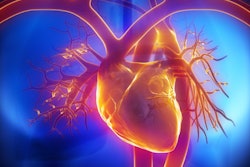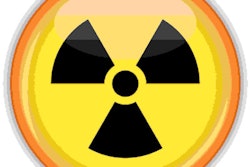
PHILADELPHIA - Artificial intelligence (AI) analysis of stress SPECT myocardial perfusion imaging (MPI) can be highly sensitive for all types of coronary artery disease (CAD), according to research presented Tuesday at the Society of Nuclear Medicine and Molecular Imaging (SNMMI) annual meeting.
A multi-institutional and multinational research group found that a machine-learning algorithm outperformed visual diagnosis or automated total perfusion deficit analysis for predicting the presence of CAD -- including high-risk CAD -- without increasing false-positive results. As a result, patients with a normal score from the machine-learning algorithm could safely be discharged and not have to receive rest imaging.
"The [machine-learning] algorithm would allow for an automated stress-first myocardial perfusion imaging protocol," said presenter Dr. Evann Eisenberg of Cedars-Sinai Medical Center in Los Angeles.
Stress-first MPI
A normal stress SPECT MPI exam carries the same benign prognosis as a normal stress/rest imaging protocol, and additional rest imaging offers low value in these patients, according to Eisenberg. Performing stress MPI first is safe and it can also reduce costs, radiation exposure, and laboratory time. However, physician verification of the stress imaging is required prior to canceling the rest imaging study, she said.
"Additionally, it's unclear which patients should be stratified for a stress-first imaging protocol," Eisenberg said.
As a result, the researchers sought to create a machine-learning score from stress-only SPECT MPI for predicting obstructive and high-risk CAD. This would then allow them to develop an automated stress-first imaging protocol that would be highly sensitive for CAD and could be immediately generated and verified by the technologist, according to Eisenberg.
They used the Registry of Fast Myocardial Perfusion Imaging with Next Generation SPECT (ReFINe SPECT) clinical imaging database, a database funded by the U.S. National Institutes of Health that was developed by nine centers from four countries and includes images from a combination of gamma cameras from GE Healthcare and Spectrum Dynamics. The database comprises a prognostic registry of 20,418 cases from five centers and a diagnostic registry of 2,079 cases.
The study population included 1,925 cases from the database's diagnostic registry of patients who didn't have known CAD and who had received SPECT MPI and invasive coronary angiography over a six-month period. Clinical imaging and invasive angiography variables were collected at each individual site, deidentified, and sent to a single core laboratory, which produced automated total perfusion deficit and machine-learning scores.
The study end points were defined as follows:
- Obstructive CAD:
- 70% or greater stenosis of the left anterior descending artery (LAD), left circumflex coronary artery (LCx), or right coronary artery (RCA)
- 50% or greater stenosis in the left main coronary artery (LMCA)
- High-risk CAD:
- 50% or greater stenosis in the LMCA
- Three-vessel CAD
- Two-vessel CAD with ≥ 50% stenosis in the LMCA or ≥ 70% stenosis in the proximal LAD
Of the 1,925 patients in the study, 1,207 had obstructive CAD, while 118 patients had 50% or greater stenosis in the LMCA, 263 patients had three-vessel CAD, and 143 patients had high-risk two-vessel CAD.
Machine-learning score
Each study was interpreted by visual diagnosis, automated total perfusion deficit analysis, and machine learning. Readers performing visual assessment had access to all imaging and clinical data, and they provided a score of either 0 (definitely normal), 1 (abnormal), 2 (equivocal), or 3 (abnormal).
Automated total perfusion deficit was performed on the stress-only raw data with a threshold of less than 1%. A machine-learning score was calculated from stress-only imaging as well, but it also incorporated clinical variables. Of the imaging data used in the study, 90% were used for training and 10% for testing. The researchers performed 10-fold cross-validation.
From performing receiver operating characteristic (ROC) analysis, machine learning produced the highest area under the curve (AUC) for detecting obstructive CAD:
- Machine learning: AUC = 0.837
- Total perfusion deficit: AUC = 0.785
- Readers: AUC = 0.698
A machine-learning threshold score of 0.3 yielded the highest sensitivity for obstructive CAD, including the high-risk cases.
| Sensitivity for obstructive CAD | |||
| Readers | Automated total perfusion deficit analysis | Machine-learning score | |
| Any obstructive CAD | 83% | 82% | 95% |
| LMCA stenosis ≥ 50% | 77% | 78% | 94% |
| 3-vessel CAD | 89% | 87% | 98% |
| High-risk 2-vessel CAD | 87% | 90% | 97% |
Machine learning also had the fewest false-negative results of the three interpretation methods.
| Percentage of patients with CAD despite having negative test results | |||
| Readers | Automated total perfusion deficit analysis | Machine-learning score | |
| Any obstructive CAD | 17% | 17% | 5% |
| LMCA stenosis ≥ 50% stenosis | 23% | 22% | 6% |
| 3-vessel CAD | 13% | 11% | 2% |
| High-risk 2-vessel CAD | 13% | 10% | 3% |
A machine-learning scoring threshold of 0.3 did not increase false-positive results, Eisenberg noted.
"And, thus, you can conclude that there wouldn't be any further unnecessary rest imaging using this threshold," she said.
Proposed stress-first protocol
Based on these results, the researchers proposed a stress-first myocardial perfusion SPECT protocol. Using this protocol, patients would receive myocardial perfusion stress testing first, and the machine-learning algorithm would provide a score based on imaging and clinical variables. A patient with a machine-learning score of 0.3 or less would be considered to have a normal stress imaging result and could be safely discharged and their rest imaging canceled. Patients given a machine-learning score of 0.3 or greater would proceed with rest imaging. Physician review would be required to report the study, Eisenberg said.



















